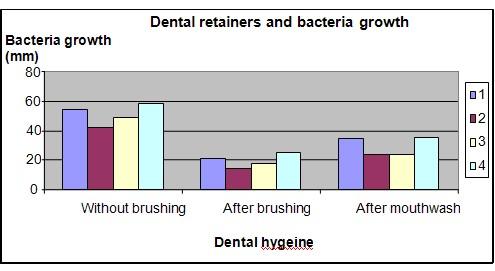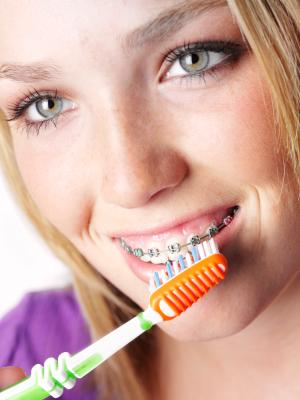| Complexity level: | 8 |
| Project cost ($): | 40 |
| Time required: | 1 hour for preparation, 8 days for experiment |
| Material availability: | Access to laboratory equipment (eg. petri dishes) |
| Safety concerns: | Always follow laboratory safety guidelines and always practice sterile technique when handling microbes. Never have any food or drink at your workstation and always thoroughly wash your hands with disinfectant soap or alcohol before leaving your workstation. Always dispose of used material in a biohazard bag. If none are available, the bacteria should be destroyed with bleach before being disposed of |
Hypothesis
There will be greater amounts of bacteria on dental retainers if they are worn without being regularly brushed with toothpaste.
Overview
Dental hygiene and retainers
Different types of microbes and bacteria can be found living inside the mouth cavity. These microorganisms live on remnants of leftover food in our mouth. Bacteria digests the starch and sugar found on the surface of our teeth and produce acids that can dissolve teeth enamel This causes tooth decay. Bacteria in our mouths is also responsible for the formation of plaque and bad breath.
Brushing our teeth regularly with tooth paste and rinsing our mouth with mouthwash are important measures necessary for maintaining good dental hygiene. This also helps to remove plaque, prevent gum disease and tooth decay.
Dental retainers are used to maintain teeth positions after the removal of braces. . Dental retainers are usually worn more regularly just after the braces are removed, thereafter, they can be worn less regularly, according to the directions of the orthodontist. Dental retainers require daily cleaning just like our teeth do, in order to prevent food residue and bacteria from accumulating. .
Scientific Terms
Materials
The materials required for this science project experiment are:
- 12 agar Petri dishes
- 12 disinfected swabs
- 1 bottle of disinfected water
- 4 toothbrushes
- sterile gloves
- 4 participants who use dental retainers
- 4 cups of water
- 1 tube of toothpaste
- 1 bottle of mouthwash
- 1 marker pen and writing material
Procedure
1. Tthe independent variable of this experiment is the conditions of which the dental retainers are subject to – non brushing, brushing with toothpaste and rinsing with mouthwash The dependent variable is the amount of bacteria growth in the relevant Petri dish. This is approximately determined by measuring the size of bacteria growth using a ruler. The constants (control variables) are room temperature, amount of sunlight and the ingredients in the Petri dish agar.
2. Prepare 12 Petri dishes of agar and store them in the refrigerator. Bring them to room temperature before the start of experiment by taking them out of the refrigerator.
3. The experiment will be performed over the course of 3 days Remember to always follow laboratory safety guidelines and always practice sterile technique when handling microbes. Never have any food or drink at your workstation and always thoroughly wash your hands with disinfectant soap or alcohol before leaving your workstation. Always dispose of used material in a biohazard bag. If none are available, the bacteria should be destroyed with bleach before being disposed of. To do this, you need to ensure that you have proper safety gear (gloves, goggles, etc). Prepare a bleach solution of at least 25% concentration (diluted with 3 parts of water). Soak the petri dishes for 24 hours in the bleach solution before disposal, always being mindful that bleach is corrosive and should be handled with care.
4. On the 1st day of experiment 4 participants are required to wear their dental retainers continuously for 24 hours without brushing their teeth. After 24 hours, the participants are requested to gargle with water for 10 seconds, and to spit out the water. This simulates conditions where a person does not brush his teeth but merely rinses his mount with water.
5. Wash a cotton swab with sterilized water. Squeeze dry, then wipe the dental retainers with the washed cotton swab before rubbing the swab gently onto the agar surface in the Petri dish. Ensure that you cover the entire surface area of the dish (swab in at least 3 directions). This Petri dish is labeled “without brushing”. The Petri dish is then covered and incubated in a cool shaded place for 5 days, allowing the bacteria to colonise.
6. On the 2nd day, the participants will brush their teeth using toothpaste. Ensure that a regular bran/type of toothpaste is used - and have the participants use the same toothpaste. Wait for 4 hours after brushing, then repeat procedure 5 with their dental retainers. Label the petri dishes as “after brushing with toothpaste”. On the third day, the participants will rinse with mouthwash whilst wearing their dentures (use any regular brand, and ensure that they all use the same brand), and then after 4 hours, the procedures in paragraph 5 above will be repeated. Label this batch of petri dishes as “after rinsing with mouthwash” .
7 The diameter of the bacteria colony growth is measured for each batch of petri dishes, after 5 days of incubation, and recorded in the table provided below

Results
The results show that regular teethbrushing with toothpaste is able to reduce the amount of bacteria growth in the dental retainer. Mouthwash also reduces bacteria growth on the dental retainer, but is not as effective as brushing with toothpaste.
| Participant no. | Size of bacteria growth after 5 days (mm) | ||
| Without brushing | After brushing | After mouthwash | |
| 1 | 53.5 | 21 | 34.5 |
| 2 | 42.5 | 14.5 | 23.5 |
| 3 | 49 | 17.5 | 24 |
| 4 | 58 | 25.5 | 35 |
Use the below graph to plot the results in the above table.

Conclusion
Our hypothesis was that there will be greater amounts of bacteria on dental retainers if they are worn without being regularly brushed with toothpaste. The hypothesis has been proven to be true.
Regular teeth brushing with toothpaste is important for maintaining our oral hygiene, such as helping to prevent tooth decay and reducing the amount of bacteria growth in our mouth cavities. Users of dental retainers will need to brush and clean their retainers regularly to remove the food particles that are stuck onto the surface.
Also consider
This science fair project can be repeated by varying the time allowed for the bacteria to grow - eg. 8, 12, 24 hours. It would be interesting to see how long we should or should not wait before brushing our teeth.
Try testing with different brands of mouthwash and toothpaste to see which of these are more effective.
References
How does toothpaste clean your teeth? - http://www.ehow.com/about_4596423_toothpaste-clean-teeth.html
What are dental retainers? - http://www.wisegeek.com/what-are-dental-retainers.htm
Retainers – what is a retainer? - http://dentistry.about.com/od/dentalfactsfaqs/f/retainer.htm

